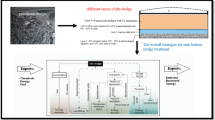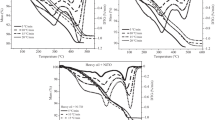Abstract
With two active O–O peroxide groups, 1,1-bis(tert-butylperoxy)cyclohexane (BTBPC) has a certain degree of thermal instability. It is usually used as an initiator in chemical processes, and therefore reckless operation may result in serious thermal accidents. This study focused on the runaway reactions of BTBPC alone and mixed with various concentrations of nitric acid (1, 2, 4, and 8 N). The essential thermokinetic parameters, such as exothermic onset temperature (T o), activation energy (E a), frequency factor (A), time to maximum rate under adiabatic condition (TMRad) and time to conversion limit (TCL), were evaluated by differential scanning calorimetry at the heating rate of 4 °C min−1, and a kinetics-based curve fitting method was used to assess the thermokinetic parameters. All the results indicated that BTBPC mixed with one more than 4 N nitric acid dramatically increased the degree of thermal hazard in the exothermic peak and became more dangerous. However, it was relatively safe for BTBPC mixed with less than 1 N nitric acid under 34.5 °C.






Similar content being viewed by others
Abbreviations
- A :
-
Frequency factor of reaction (s−1 M1−n)
- C p :
-
Specific heat capacity (J g−1 K−1)
- E a :
-
Activation energy of reaction (kJ mol−1)
- ΔHd :
-
Heat of decomposition (kJ kg−1)
- k o :
-
Pre-exponential factor (s−1)
- m :
-
Mass of reactant (g)
- N :
-
Normality of nitric acid (eq mol−1)
- n :
-
Order of reaction (dimensionless)
- n i :
-
Reaction order of ith stage (dimensionless)
- Q :
-
Total heat of decomposition (kJ kg−1)
- r i :
-
Reaction rate of ith stage (g s−1)
- r ij :
-
Reaction rate of ith stage of jth sub-stage (g s−1)
- ΔTad :
-
Adiabatic temperature rise (°C)
- TCL:
-
Time to conversion limit (day)
- T max :
-
Maximum temperature at which the peak point occurs (°C)
- TMRad :
-
Time to maximum rate under adiabatic condition (day)
- T o :
-
Exothermic onset temperature of reaction (°C)
- z :
-
Autocatalytic constant (variable)
- α :
-
Degree of conversion (dimensionless, from 0 to 1)
- β :
-
Heating rate of DSC experiment (°C min−1)
References
Talouba B, Balland L, Mouhab N, Abdelghani-Idrissi MA. Kinetic parameter estimation for decomposition of organic peroxides by means of DSC measurements. J Loss Prev Process Ind. 2011;24:391–6.
Luo KM, Chang JG, Lin SH, Chang CT, Yeh TF, Hu KH, Kao CS. The criterion of critical runaway and stable temperatures in cumene hydroperoxide reaction. J Loss Prev Process Ind. 2001;14:229–39.
Uchida T, Wakakura M, Miyake A, Ogawa T. Thermal decomposition of organic peroxide with metals using calorimeters. J Therm Anal Calorim. 2008;93:47–52.
Liaw HJ, Gerbaud V, Chen CC, Shu CM. Effect of stirring on the safety of flammable liquid mixtures. J Hazard Mater. 2010;177:1093–101.
Chang YM, You ML, Lin CH, Wu SY, Tseng JM, Lin CP, Wang YL, Shu CM. Fire and explosion hazard evaluation for the acetone aqueous solutions. J Therm Anal Calorim. 2011;106:179–89.
Wu SH, Chi JH, Huang CC, Lin NK, Peng JJ, Shu CM. Thermal hazard analyses and incompatible reaction evaluations of hydrogen peroxide by DSC. J Therm Anal Calorim. 2010;102:563–8.
Yeh PY, Shu CM, Duh YS. Thermal hazard analysis of methyl ethyl ketone peroxide. Ind Eng Chem Res. 2003;42:1–5.
Christoforatou EL, Balakotaiah V. Runaway limits for adiabatic packed-bed catalytic reactors. AIChE J. 1998;44:394–404.
Villalobos MA, Hamielec AE, Wood PE. Kinetic model for short-cycle bulk styrene polymerization through bifunctional initiators. J Appl Polym Sci. 1991;42:629–37.
Product information. ACE Chemical Corp. Taiwan R.O.C. 2011. http://www.acechem.com.tw/english/products.asp?cat=3.
Watanabe Y, Ishigaki H, Suyama S. Kinetics of bulk styrene polymerization initiated by 2, 2-bis(t-butyldioxy)alkanes. Polym J. 1992;24:257–64.
Drumright RE, Kastl PE, Priddy DB. Cycloalkane perketal initiators for styrene polymerization. 1. Decomposition chemistry of 1, l-bis(tert-buty1peroxy)cyclohexane. Macromolecules. 1993;26:2246–52.
Logvinenko V, Mikhailov K, Yukhin Yu. The kinetics of thermal decomposition of bismuth oxohydroxolaurate. J Therm Anal Calorim. 2007;88:47–9.
Liu SH, Lin CP, Shu CM. Thermokinetic parameters and thermal hazard evaluation for three organic peroxides by DSC and TAM III. J Therm Anal Calorim. 2011;106:165–72.
STARe Software with Solaris Operating System, Operating Instructions; Mettler Toledo, Sweden. 2004.
Tseng JM, Gupta JP, Lin YF, Shu CM. Evaluation and modeling runaway reaction of methyl ethyl ketone peroxide mixed with nitric acid. Ind Eng Chem Res. 2007;46:8738–45.
Chang YM, You ML, Tseng JM, Wang YL, Lin CP, Shu CM. Evaluations of fire and explosion hazard for the mixtures of benzene and methanol using rough set method. J Therm Anal Calorim. 2010;102:523–33.
Kossoy AA, Koludarova E. Specific features of kinetics evaluation in calorimetric studies of runaway reactions. J Loss Prev Process Ind. 1995;8(4):229–35.
Kossoy AA, Akhmetshin Yu. Identification of kinetic models for the assessment of reaction hazards. Process Saf Prog. 2007. http://dx.doi.org/10.1002/prs.10189.
Townsend DI, Tou JC. Thermal hazard evaluation by an accelerating rate calorimeter. Thermochim Acta. 1980;37:1–30.
Kossoy AA, Benin AI, Akhmetshin YG. An advanced approach to reactivity rating. J Hazard Mater. 2005;118:9–17.
You ML, Tseng JM, Liu MY, Shu CM. Runaway reaction of lauroyl peroxide with nitric acid by DSC. J Therm Anal Calorim. 2010;102:535–9.
Acknowledgements
The authors wish to express their gratitude to Dr. Arcady A. Kossoy of ChemInform Saint Petersburg (CISP), Ltd., St. Petersburg, Russia, for providing technical assistance. The authors would also like to thank Dr. Jo-Ming Tseng for valuable suggestions on experiments and the measurements of a runaway reaction.
Author information
Authors and Affiliations
Corresponding author
Rights and permissions
About this article
Cite this article
Hsueh, KH., Chen, WT., Chu, YC. et al. Thermal reactive hazards of 1,1-bis(tert-butylperoxy)cyclohexane with nitric acid contaminants by DSC. J Therm Anal Calorim 109, 1253–1260 (2012). https://doi.org/10.1007/s10973-012-2338-y
Published:
Issue Date:
DOI: https://doi.org/10.1007/s10973-012-2338-y




